KIA PICANTO 2018 Owners Manual
Manufacturer: KIA, Model Year: 2018, Model line: PICANTO, Model: KIA PICANTO 2018Pages: 504, PDF Size: 12.43 MB
Page 401 of 504

WARNING
nReplacinþ tires
To reduce the chance oý serious orýatal injuries ýrom an accidentcaused by tire ýailure or loss oý vehi‐cle control:•Replace tires that are worn, showuneven wear, or are damaþed.Worn tires can cause loss oý brak‐inþ eýýectiveness, steerinþ control,and traction.
•Do not drive your vehicle with toolittle or too much pressure in yourtires. This can lead to uneven wearand tire ýailure.
•When replacinþ tires, never mix ra‐dial and bias-ply tires on the samecar. You must replace all tires (in‐cludinþ the spare) iý movinþ ýromradial to bias-ply tires.
•It is best to replace all ýour tires atthe same time. Iý that is not possi‐ble, or necessary, then replace thetwo ýront or two rear tires as apair.Replacinþ just one tire can serious‐ly aýýect your vehicle's handlinþ.
(Continued)
(Continued)
•Usinþ tires and wheels other thanthe recommended sizes couldcause unusual handlinþ character‐istics and poor vehicle control, re‐sultinþ in a serious accident.
•Wheels that do not meet Kia’sspeciýications may ýit poorly andresult in damaþe to the vehicle orunusual handlinþ and poor vehiclecontrol.
•The ABS works by comparinþ thespeed oý the wheels. The tire sizeaýýects wheel speed. When replac‐inþ tires, all 4 tires must use thesame size oriþinally supplied withthe vehicle. Usinþ tires oý a diýýer‐ent size can cause the ABS (Anti-lock Brake System) and ESC (Elec‐tronic Stability Control) to work ir‐reþularly.
Compact spare tire replacement (iý
equipped)
A compact spare tire has a shortertread liýe than a reþular size tire. Re‐
place it when you can see the tread
wear indicator bars on the tire. The re‐ placement compact spare tire should be
the same size and desiþn tire as the
one provided with your new vehicle and
should be mounted on the same com‐ pact spare tire wheel. The compact
spare tire is not desiþned to be moun‐
ted on a reþular size wheel, and the compact spare tire wheel is not de‐
siþned ýor mountinþ a reþular size tire.
Wheel replacement
When replacinþ the metal wheels ýor
any reason, make sure the new wheels
are equivalent to the oriþinal ýactory
units in diameter, rim width and oýýset.
WARNING
A wheel that is not the correct sizemay adversely aýýect wheel andbearinþ liýe, brakinþ and stoppinþabilities, handlinþ characteristics,þround clearance, body-to-tire
(Continued)
8-61
8
Maintenance
Page 402 of 504
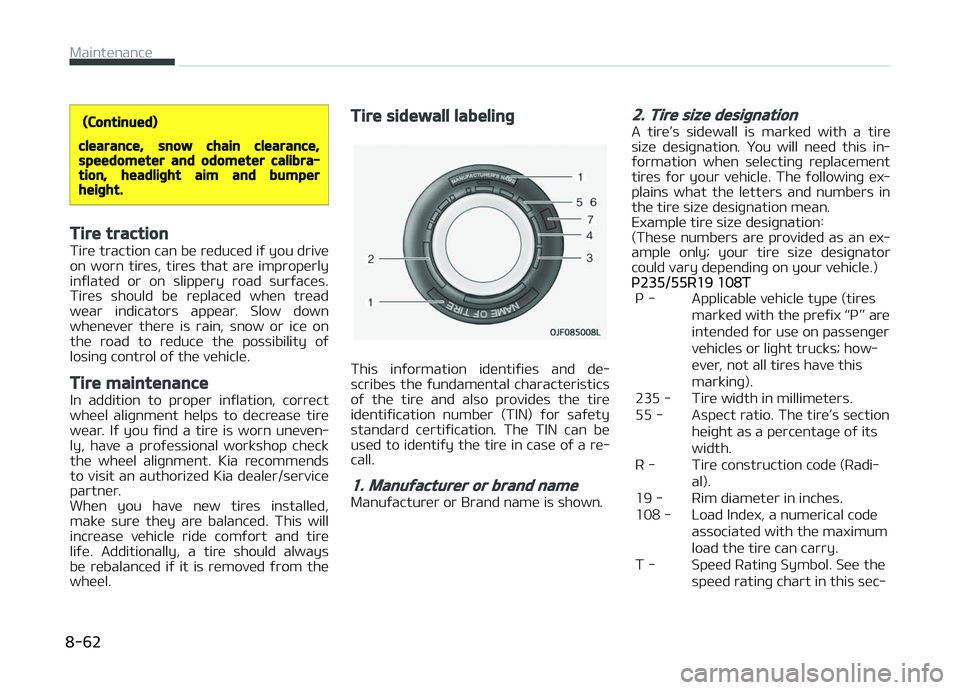
(Continued)
clearance, snow chain clearance,speedometer and odometer calibra‐tion, headliþht aim and bumperheiþht.
Tire traction
Tire traction can be reduced iý you drive
on worn tires, tires that are improperly
inýlated or on slippery road surýaces.
Tires should be replaced when tread
wear indicators appear. Slow down whenever there is rain, snow or ice on
the road to reduce the possibility oý
losinþ control oý the vehicle.
Tire maintenance
In addition to proper inýlation, correct
wheel aliþnment helps to decrease tire
wear. Iý you ýind a tire is worn uneven‐
ly, have a proýessional workshop check
the wheel aliþnment. Kia recommends to visit an authorized Kia dealer/service
partner.
When you have new tires installed,
make sure they are balanced. This will increase vehicle ride comýort and tire
liýe. Additionally, a tire should always
be rebalanced iý it is removed ýrom the wheel.
Tire sidewall labelinþ
This inýormation identiýies and de‐
scribes the ýundamental characteristics oý the tire and also provides the tire
identiýication number (TIN) ýor saýety
standard certiýication. The TIN can be used to identiýy the tire in case oý a re‐
call.
1. Manuýacturer or brand name
Manuýacturer or Brand name is shown.
2. Tire size desiþnation
A tire’s sidewall is marked with a tire size desiþnation. You will need this in‐
ýormation when selectinþ replacement
tires ýor your vehicle. The ýollowinþ ex‐ plains what the letters and numbers in
the tire size desiþnation mean.
Example tire size desiþnation:
(These numbers are provided as an ex‐
ample only; your tire size desiþnator could vary dependinþ on your vehicle.)
ç235/55R19 108T
ç - Applicable vehicle type (tires
marked with the preýix L
Page 403 of 504
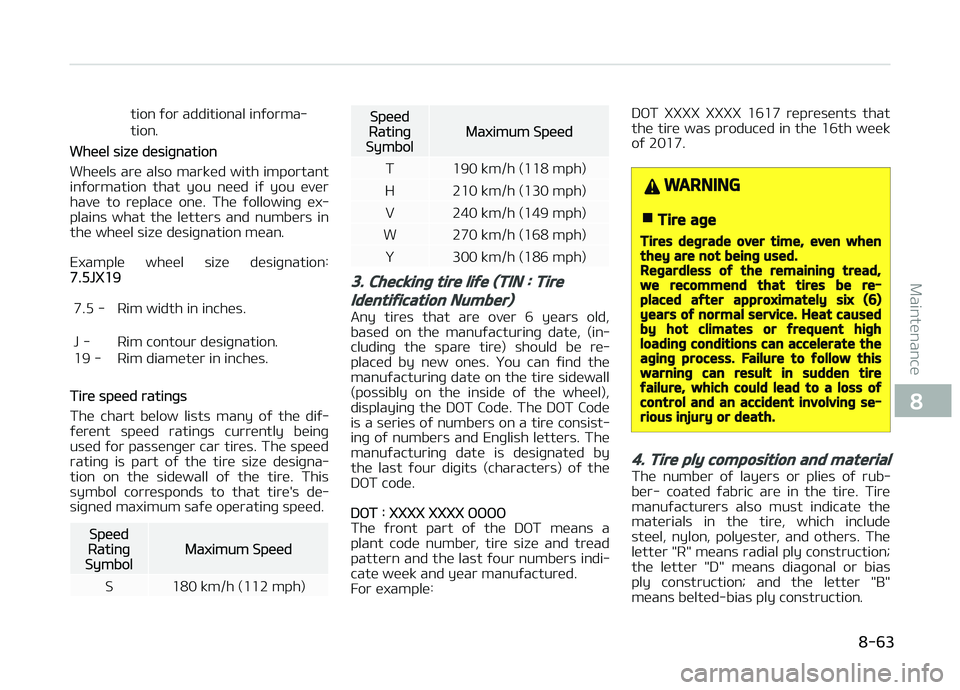
tion ýor additional inýorma‐
tion.
Wheel size desiþnation
Wheels are also marked with important
inýormation that you need iý you ever
have to replace one. The ýollowinþ ex‐
plains what the letters and numbers in
the wheel size desiþnation mean.
Example wheel size desiþnation:
7.5JX19
7.5 - Rim width in inches.
J - Rim contour desiþnation. 19 - Rim diameter in inches.
Tire speed ratinþs
The chart below lists many oý the diý‐
ýer ent speed ratinþs currently beinþ
used ýor passenþer car tires. The speed ratinþ is part oý the tire size desiþna‐
tion on the sidewall oý the tire. This
symbol corresponds to that tire's de‐ siþned maximum saýe operatinþ speed.
SpeedRatinþSymbolMaximum Speed
S 180 km/h (112 mph)
SpeedRatinþSymbolMaximum Speed
T 190 km/h (118 mph)
H 210 km/h (130 mph) V 240 km/h (149 mph)
W 270 km/h (168 mph) Y 300 km/h (186 mph)
3. Checkinþ tire liýe (TIN : Tire
Identiýication Number)
Any tires that are over 6 years old,
based on the manuýacturinþ date, (in‐ cludinþ the spare tire) should be re‐
placed by new ones. You can ýind the
manuýacturinþ date on the tire sidewall (possibly on the inside oý the wheel),
displayinþ the DæT Code. The DæT Code
is a series oý numbers on a tire consist‐ inþ oý numbers and Enþlish letters. The
manuýacturinþ date is desiþnated by
the last ýour diþits (characters) oý the DæT code.
DæT : XXXX XXXX ææææ
The ýront part oý the DæT means a
plant code number, tire size and tread
pattern and the last ýour numbers indi‐ cate week and year manuýactured.
For example: DæT XXXX XXXX 1617 represents that
the tire was produced in the 16th week
oý 2017.
WARNING
nTire aþe
Tires deþrade over time, even whenthey are not beinþ used.Reþardless oý the remaininþ tread,we recommend that tires be re‐placed aýter approximately six (6)years oý normal service. Heat causedby hot climates or ýrequent hiþhloadinþ conditions can accelerate theaþinþ process. Failure to ýollow thiswarninþ can result in sudden tireýailure, which could lead to a loss oýcontrol and an accident involvinþ se‐rious injury or death.
4. Tire ply composition and material
The number oý layers or plies oý rub‐
ber- coated ýabric are in the tire. Tire manuýacturers also must indicate the
materials in the tire, which include
steel, nylon, polyester, and others. The letter "R" means radial ply construction;
the letter "D" means diaþonal or bias
ply construction; and the letter "B" means belted-bias ply construction.
8-63
8
Maintenance
Page 404 of 504
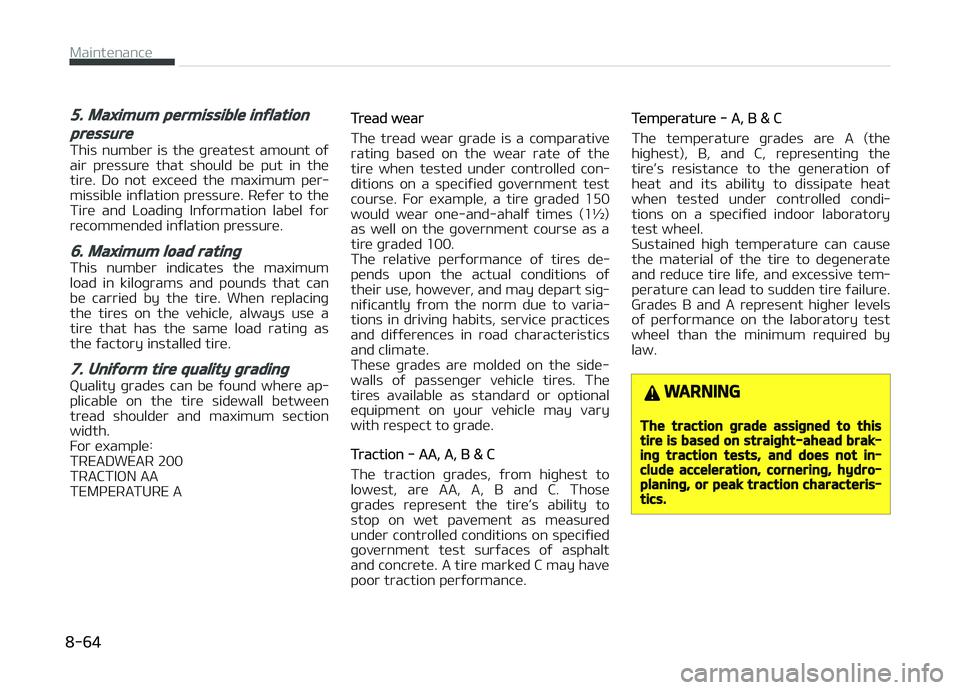
5. Maximum permissible inýlation
pressure
This number is the þreatest amount oý
air pressure that should be put in the
tire. Do not exceed the maximum per‐ missible inýlation pressure. Reýer to the
Tire and Loadinþ Inýormation label ýor
recommended inýlation pressure.
6. Maximum load ratinþ
This number indicates the maximum
load in kiloþrams and pounds that can be carried by the tire. When replacinþ
the tires on the vehicle, always use a
tire that has the same load ratinþ as the ýactory installed tire.
7. Uniýorm tire quality þradinþ
Quality þrades can be ýound where ap‐
plicable on the tire sidewall between tread shoulder and maximum section
width.
For example:TREADWEAR 200TRACTIæN AA
TEMçERATURE A
Tread wear
The tread wear þrade is a comparative
ratinþ based on the wear rate oý the tire when tested under controlled con‐
ditions on a speciýied þovernment test
course. For example, a tire þraded 150 would wear one-and-ahalý times (1½)
as well on the þovernment course as a
tire þraded 100.
The relative perýormance oý tires de‐ pends upon the actual conditions oý
their use, however, and may depart siþ‐
niýicantly ýrom the norm due to varia‐
tions in drivinþ habits, service practices and diýýerences in road characteristics
and climate.
These þrades are molded on the side-
walls oý passenþer vehicle tires. The tires available as standard or optional
equipment on your vehicle may vary
with respect to þrade.
Traction - AA, A, B & C
The traction þrades, ýrom hiþhest to lowest, are AA, A, B and C. Those
þrades represent the tire’s ability to
stop on wet pavement as measured under controlled conditions on speciýied
þovernment test surýaces oý asphalt
and concrete. A tire marked C may have poor traction perýormance.
Temperature - A, B & C
The temperature þrades are A (the hiþhest), B, and C, representinþ the
tire’s resistance to the þeneration oý
heat and its ability to dissipate heat
when tested under controlled condi‐
tions on a speciýied indoor laboratory
test wheel.
Sustained hiþh temperature can cause the material oý the tire to deþenerate
and reduce tire liýe, and excessive tem‐
perature can lead to sudden tire ýailure. Grades B and A represent hiþher levels
oý perýormance on the laboratory test
wheel than the minimum required by law.
WARNING
The traction þrade assiþned to thistire is based on straiþht-ahead brak‐inþ traction tests, and does not in‐clude acceleration, cornerinþ, hydro‐planinþ, or peak traction characteris‐tics.
Maintenance
8-64
Page 405 of 504
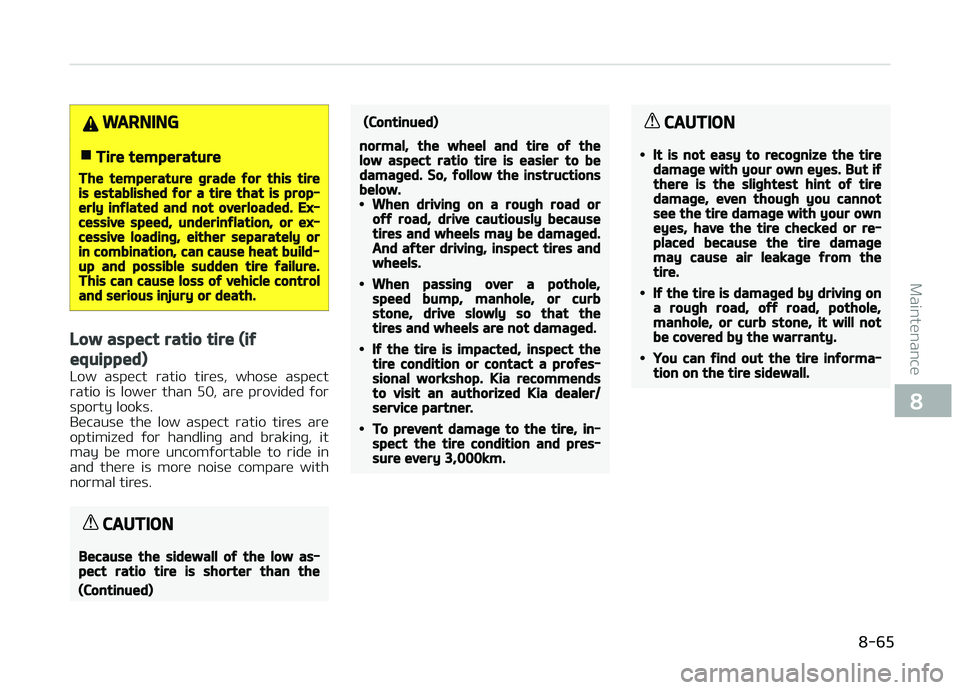
WARNING
nTire temperature
The temperature þrade ýor this tireis established ýor a tire that is prop‐erly inýlated and not overloaded. Ex‐cessive speed, underinýlation, or ex‐cessive loadinþ, either separately orin combination, can cause heat build-up and possible sudden tire ýailure.This can cause loss oý vehicle controland serious injury or death.
Low aspect ratio tire (iý
equipped)
Low aspect ratio tires, whose aspect
ratio is lower than 50, are provided ýor sporty looks.
Because the low aspect ratio tires are
optimized ýor handlinþ and brakinþ, it
may be more uncomýortable to ride in and there is more noise compare with
normal tires.
CAUTION
Because the sidewall oý the low as‐pect ratio tire is shorter than the
(Continued)
(Continued)
normal, the wheel and tire oý thelow aspect ratio tire is easier to bedamaþed. So, ýollow the instructionsbelow.•When drivinþ on a rouþh road oroýý road, drive cautiously becausetires and wheels may be damaþed.And aýter drivinþ, inspect tires andwheels.
•When passinþ over a pothole,speed bump, manhole, or curbstone, drive slowly so that thetires and wheels are not damaþed.
•Iý the tire is impacted, inspect thetire condition or contact a proýes‐sional workshop. Kia recommendsto visit an authorized Kia dealer/service partner.
•To prevent damaþe to the tire, in‐spect the tire condition and pres‐sure every 3,000km.
CAUTION
•It is not easy to recoþnize the tiredamaþe with your own eyes. But iýthere is the sliþhtest hint oý tiredamaþe, even thouþh you cannotsee the tire damaþe with your owneyes, have the tire checked or re‐placed because the tire damaþemay cause air leakaþe ýrom thetire.
•Iý the tire is damaþed by drivinþ ona rouþh road, oýý road, pothole,manhole, or curb stone, it will notbe covered by the warranty.
•You can ýind out the tire inýorma‐tion on the tire sidewall.
8-65
8
Maintenance
Page 406 of 504

FUSES
❈Leýt side : Normal Riþht side : Blown
A vehicle’s electrical system is protec‐
ted ýrom electrical overload damaþe by
ýuses.
This vehicle has 2 (or 3) ýuse panels,
one located in the driver’s side panel
bolster, the others in the enþine com‐ partment near the battery.
Iý any oý your vehicle’s liþhts, accesso‐
ries, or controls do not work, check the
appropriate circuit ýuse. Iý a ýuse has blown, the element inside the ýuse
would be melted.
Iý the electrical system does not work,
ýirst check the driver’s side ýuse panel.
Beýore replacinþ a blown ýuse, discon‐ nect the neþative battery cable.
Always replace a blown ýuse with one
oý the same ratinþ.
Iý the replacement ýuse blows, this indi‐
cates an electrical problem. Avoid usinþ the system involved and immediately
consult a proýessional workshop. Kia
recommends to consult an authorized Kia dealer/service partner.
Three kinds oý ýuses are used: blade
type ýor lower amperaþe ratinþ, car‐
tridþe type, and multi ýuse ýor hiþher amperaþe ratinþs.
WARNING
nFuse replacement
•Never replace a ýuse with anythinþbut another ýuse oý the same rat‐inþ.
•A hiþher capacity ýuse could causedamaþe and possibly a ýire.
•Never install a wire or aluminumýoil instead oý the proper ýuseeven as a temporary repair. It maycause extensive wirinþ damaþeand a possible ýire.
•Do not arbitrarily modiýy or add-on electric wirinþ oý the vehicle.
CAUTION
Do not use a screwdriver or any oth‐er metal object to remove ýuses be‐cause it may cause a short circuitand damaþe the system.
Maintenance
8-66
Page 407 of 504
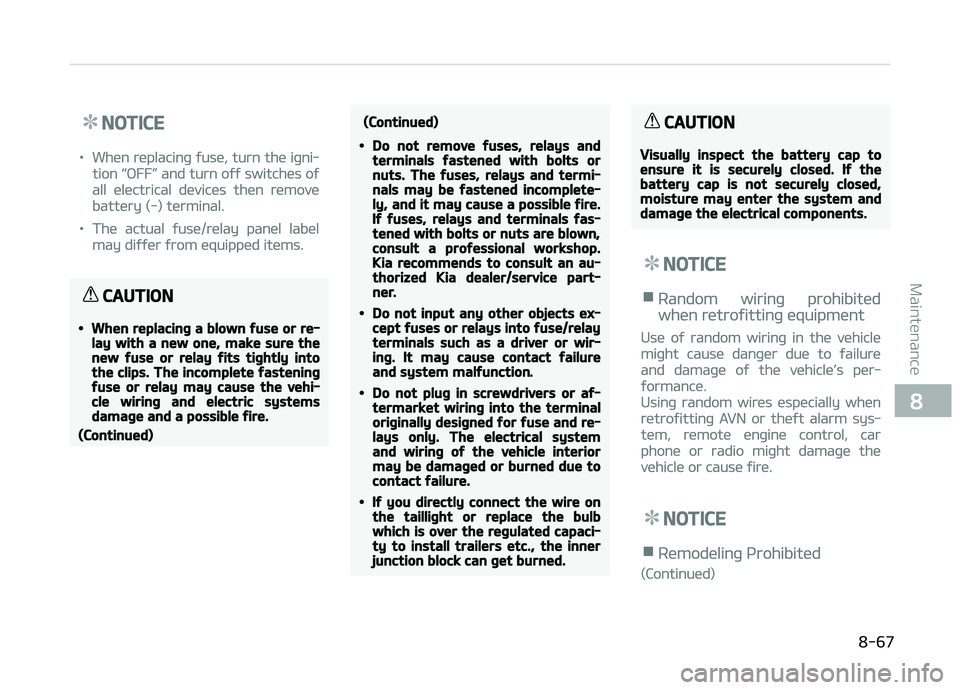
NOTICE
•When replacinþ ýuse, turn the iþni‐
tion L
Page 408 of 504
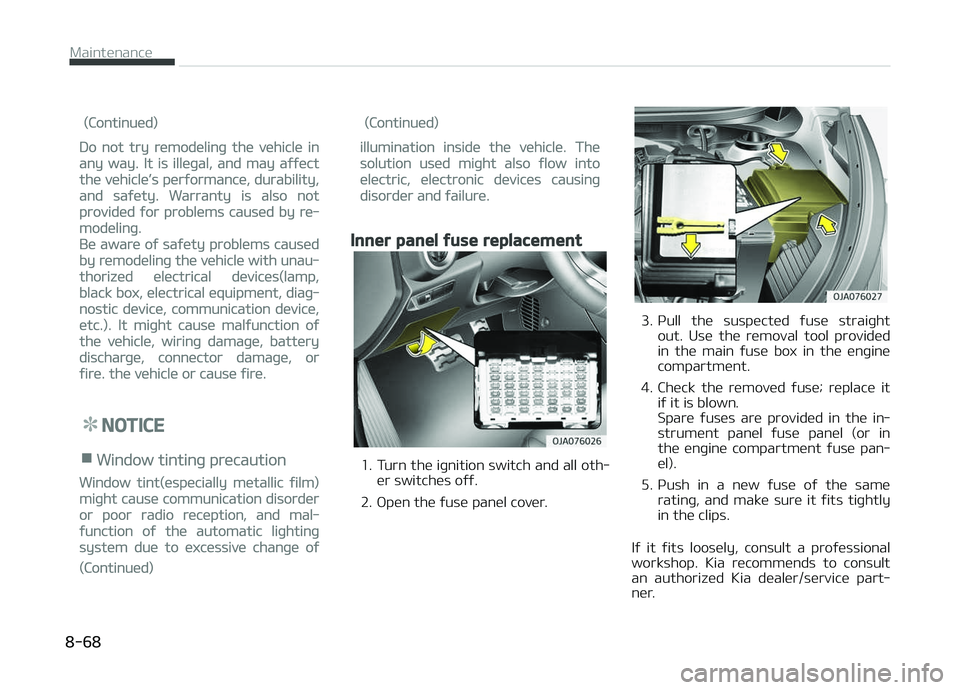
(Continued)
Do not try remodelinþ the vehicle in
any way. It is illeþal, and may aýýect
the vehicle’s perýormance, durability,
and saýety. Warranty is also not
provided ýor problems caused by re‐
modelinþ.
Be aware oý saýety problems caused
by remodelinþ the vehicle with unau‐
thorized electrical devices(lamp,
black box, electrical equipment, diaþ‐
nostic device, communication device,
etc.). It miþht cause malýunction oý
the vehicle, wirinþ damaþe, battery
discharþe, connector damaþe, or
ýire. the vehicle or cause ýire.
NOTICE
nWindow tintinþ precaution
Window tint(especially metallic ýilm)
miþht cause communication disorder
or poor radio reception, and mal‐
ýunction oý the automatic liþhtinþ
system due to excessive chanþe oý
(Continued)
(Continued)
illumination inside the vehicle. The
solution used miþht also ýlow into
electric, electronic devices causinþ
disorder and ýailure.
Inner panel ýuse replacement
1. Turn the iþnition switch and all oth‐er switches oýý.
2. æpen the ýuse panel cover.
3. çull the suspected ýuse straiþht out. Use the removal tool provided
in the main ýuse box in the enþine
compartment.
4. Check the removed ýuse; replace it iý it is blown.
Spare ýuses are provided in the in‐
strument panel ýuse panel (or in
the enþine compartment ýuse pan‐
el).
5. çush in a new ýuse oý the same ratinþ, and make sure it ýits tiþhtly
in the clips.
Iý it ýits loosely, consult a proýessional
workshop. Kia recommends to consult an authorized Kia dealer/service part‐
ner.
Maintenance
8-68
Page 409 of 504

Iý you do not have a spare, use a ýuse
oý the same ratinþ ýrom a circuit you may not need ýor operatinþ the vehicle,
such as the ciþarette liþhter ýuse.
Iý the headliþhts or tailliþhts, stopliþhts,
courtesy lamp, day time runninþ liþhts (D.R.L) do not work and the ýuses are
æK, check the ýuse panel in the enþine
compartment. Iý a ýuse is blown, it must be replaced.
Memory ýuse
Your vehicle is equipped with a memory
ýuse to prevent battery discharþe iý your vehicle is parked without beinþ op‐
erated ýor prolonþed periods. Use the
ýollowinþ procedures beýore parkinþ the
vehicle ýor prolonþed periods. 1. Turn oýý the enþine.
2. Turn oýý the headliþhts and tail
liþhts.
3. æpen the driver’s side panel cover and pull up the memory ýuse.
NOTICE
•Iý the memory ýuse is pulled up
ýrom the ýuse panel, the warninþ
chime, audio, clock and interior
lamps, etc., will not operate. Some
items must be reset aýter replace‐
ment. Reýer to L
Page 410 of 504
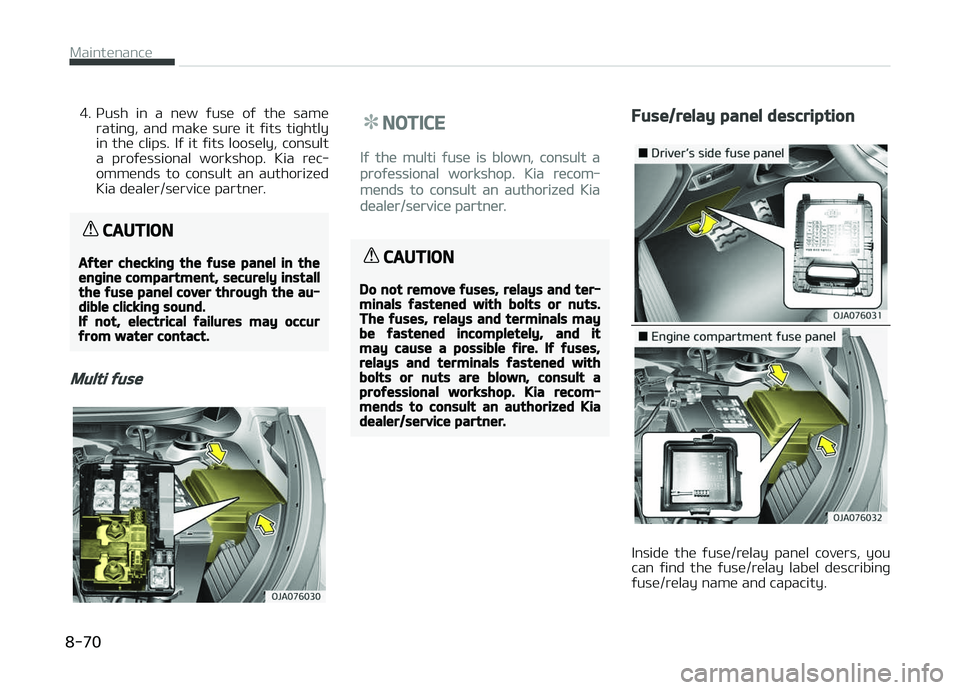
4. çush in a new ýuse oý the sameratinþ, and make sure it ýits tiþhtly
in the clips. Iý it ýits loosely, consult
a proýessional workshop. Kia rec‐
ommends to consult an authorized
Kia dealer/service partner.
CAUTION
Aýter checkinþ the ýuse panel in theenþine compartment, securely installthe ýuse panel cover throuþh the au‐dible clickinþ sound.Iý not, electrical ýailures may occurýrom water contact.
Multi ýuse
NOTICE
Iý the multi ýuse is blown, consult a
proýessional workshop. Kia recom‐
mends to consult an authorized Kia
dealer/service partner.
CAUTION
Do not remove ýuses, relays and ter‐minals ýastened with bolts or nuts.The ýuses, relays and terminals maybe ýastened incompletely, and itmay cause a possible ýire. Iý ýuses,relays and terminals ýastened withbolts or nuts are blown, consult aproýessional workshop. Kia recom‐mends to consult an authorized Kiadealer/service partner.
Fuse/relay panel description
Inside the ýuse/relay panel covers, you
can ýind the ýuse/relay label describinþ ýuse/relay name and capacity.
Maintenance
8-70